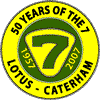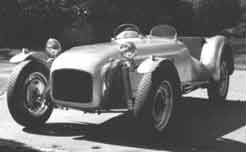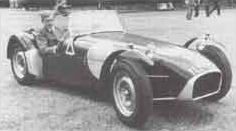
The car itself was formally launched at the 1957
Earls Court Motor Show although no actual vehicle was provided for
the display stand. The Elite took pride of place, the Seven being
displayed only as part of the Lotus brochure; sufficient evidence of
Chapman’s priorities if any was needed. However, it was the Seven
that kept Lotus going from a cashlow point of view. The Elite was
proving a difficult car to “productionise” following the
emergence of problems with its all fibreglass construction. As a
result, deliveries were delayed. It was the Seven which was keeping
Lotus afloat. The basic cost of a Seven was £1,036 fully built and
£536 in kit form. Almost inevitably, most were sold as kits, the
huge price differential being due to the swingeing Purchase Tax
charged on fully built cars. Car components were totally exempt. In
fact, the burgeoning kit car industry which emerged in Britain in
the 1950’s was very much a product of this tax loophole.
Before long, alternative engines offering more
power were made available. The 75 hp 1,100 cc Coventry Climax as
already fitted to Lewis’ prototype was one option. In addition,
particularly with the American market in mind, the BMC “A”
series engine (as fitted to the Austin Healey Sprite - already a
good seller in the USA) became another option. Although no more
powerful than the Ford 100E, the “A” series possessed more
sporty characteristics than the asthmatic Ford and proved a more
popular choice. Despite the cash flow being generated by Seven
sales, when (eventually) a cost accounting exercise was carried out
on Seven production, it was discovered that each car sold was
actually losing money for the company. The main problem was the high
labour content involved in the manufacture of the all aluminium clad
chassis. A radical rethink of the Seven was required.
The Lotus S2 1960-1962
The revised Seven Series 2 emerged in 1960. The
main differences compared to the Series 1 were, reduced tubing in
the spaceframe, replacement of the aluminium nosecone and wings by
fibreglass items, replacement of the Nash Metropolitan rear axle by
that from the Standard 10 and locating it by use of a triangulated A
frame, shortening of the rear under tray, enlargement of the fuel
tank and redesign of the rack and pinion steering allowing the pedal
box to be lengthened. All these changes helped reduce the production
costs.
Engine options remained much as before although
the emergence of the new low-line Ford Anglia with its 105E engine
allowed a more modern Ford engine to be offered. The main weakness
of the Seven 2 lay with the Standard 10 axle. The unit proved prone
to leakage resulting in seized differentials. The problem arose
because of the differential housing being prised open under
acceleration forces. Most owners were forced to have the axles
modified by increasing the strength and number of bolts holding the
differential casing together. Despite these shortcomings, the Series
2 sold better than the Series 1.
The car became more known to the public at large,
partly because of its appearance in the TV series, “The
Prisoner”. However, Lotus as a business was gradually moving away
from its roots as a specialist/kit-car manufacturer. By 1966, they
had won the Formula One World Championship twice (1963 and 1965),
were producing the successful Elan (they never really sorted the
Elite) and had moved to a new factory at Hethel in Norfolk. Chapman,
who had always “tolerated” the Seven rather than
enthusiastically supported it, was now of a mind to discontinue
production.
It was at this point that the importance of
Caterham Cars and Graham Nearn came to the fore. Almost from the
inception of the Seven, Caterham Car Sales had been very involved as
dealers of the type. It was Caterham’s undaunted support for the
car which prevented its demise in 1966 and, in 1967, they became
sole distributors, effectively taking over marketing, promotion and
sales from Lotus. However, by 1968, it was seen that the Seven was
in need of further updating and plans were afoot to design the
Series 3.
The Lotus S3 1968-1970
As often the case with the Seven, availability of
components was (and still is, to some extent) the driver behind
major redesigns. By 1968, Standard 10 back axles were virtually
extinct. A replacement was urgently needed. Also, a new range of
Crossflow Ford engines had arrived on the scene. Fitted to the Lotus
Cortina GT and later, sporty versions of the new Escort Mk.1, the
Crossflow quickly established its credentials. It was the arrival of
Formula Ford racing in 1967 which really marked the Crossflow as a
desirable engine as it was the standard engine fitted to these
racers. The back axle problem was solved by Ford making available to
Lotus brand new Escort Mexico units which were ideal, being much
stronger than that from the old Standard. The main external
difference between the Series 2 and 3 was the widening of the rear
wings to accommodate the new, wider axle.
The performance of the Series 3 Sevens was
dependent on the engines installed. The 1600cc Crossflow equipped
car’s 0 to 60 mph time (in 84 hp single carb’ form) was given as
7.7 seconds. The cream of the bunch however was the Twin Cam Seven
SS. Fitted with the 1,588 cc Lotus Twin Cam from the Elan, this
Seven pushed out 125 hp and was capable of 0 to 60 in 6.2seconds. It
was the most powerful, most expensive (cost was £1,225 - in kit
form!) and fastest Seven to date. Only thirteen were officially
built and they are recognised today as probably the most desirable
of the Lotus built Sevens. By the end of 1969, however, the future
of the Seven was again under discussion at Lotus.
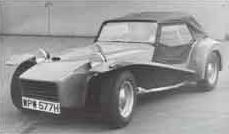
The Lotus S4 1970-1972
On this occasion, the perceived wisdom at Lotus
was that the market for a “Clubman” type road going racer had
reduced and what was needed was a more “lifestyle” orientated
car. A car more properly aimed at the new “Jet - Set” or
“Beautiful People” generation perhaps? Certainly the emergence
of “fun” vehicles such as Bond Bugs, Beach Buggies etc in the
late 60’s must have influenced the decision making process at
Lotus. What emerged was something of a hybrid.
Although designated as the Lotus Seven Series 4,
the new car had very little in common with its three predecessors,
apart from maybe a continuation of the lightweight and minimal
comfort philosophy. In fact, officially the car was given a
different Mark number, its correct designation being the Lotus 60.
Gone was the steel spaceframe and aluminium body. In its place was a
mild steel tubular structure with fabricated stressed steel side
panels and front section with an all
fibreglass body shell. The bonnet was now hinged rather than lift off and
the driver and passenger were more “cosetted” (not a word
normally associated with Sevens) Existing Seven fans were somewhat
disgruntled by the departure from the original concept but it must
be said that most of the magazine reviews of the car were favourable. The motoring hacks looked on the 4 as a distinct
improvement and, what’s more, the sales rate actually increased,
lending some credence to the basic assumption of the changing
customer base. Engine options were retained from the 3. Performance
figures showed only slight reduction on the earlier mark, mainly due
to the higher basic weight of the car. Yet again, however, problems
were emerging for the Seven. Although the sales rate of the Series 4
was higher than for the Series 3, it wasn’t high enough to recoup
the development costs which had been greater than anticipated. The
curtain was finally coming down on Lotus’ involvement with the
Seven.
The Caterham S4 1973-1974
It was now 1971 and Colin Chapman had finally
decided that the Seven’s days were definitely numbered. The Series
4 was selling better than its predecessors but the model didn’t
really fit into the image of a “supercar” manufacturer. Almost
as important, however, was the upcoming introduction of Value Added
Tax. VAT was being introduced in April 1973 as part of Britain's
entry into the EEC. Unlike Purchase Tax, which it was to replace,
VAT did not differentiate between fully assembled cars and cars sold
in component form. VAT would apply to both. The last incentive for
Lotus retaining a “home assembly” car in their line up was
going. However, Chapman did recognise Caterham Cars’ involvement
in the Seven. Indeed, the Seven had become that company's main line
of business.
In 1971, Chapman offered Graham Nearn first option
on taking over production of the Seven when the time was right. That
time arrived in June 1973 when the manufacturing rights for the car
were formally handed over to Caterham Cars. If the future of the
Seven seemed secure, this was not the case as a number of
difficulties had still to be overcome. Obviously, the version of the
Seven Caterham were committed to produce was the current model i.e.
The Series 4. Once the stock of former Lotus components were used,
Caterham ran into a problem. The suppliers of the windscreen and
hood were unwilling to supply Caterham with the rather small numbers
of components required, they were more used to dealing with much
bigger orders.
Yet again the Seven looked like it had reached the
end of the road. This time, the saving of the car were the original
“enthusiast” contingent. Caterham cars had realised that there
was a healthy second hand market for the Series 3. It did not take
them long to recognise that new production Series 3 cars, provided
they were built in the correct numbers, would find a steady market.
A quick check with the old suppliers of the various Series 3
components confirmed that all the original tools and jigs were still
in existence and that the components could be supplied at economic
rates.
The Series 4 became history and, without fanfare,
the Series 3 came back into production. These were difficult time
for the British economy, the Arab-Israeli war of October 1973 had
sent fuel prices spiraling. Luxury and sports car sales suffered as
a result. Industry was on three day week causing power cuts, strikes
and other inconveniences. However, being small and flexible,
Caterham were able to ride the storm and continued to meet the small
but steady demand for the car.
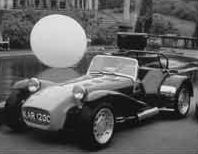
The Caterham S3 1974 - onwards
Initially, the Caterham Seven Series 3 was
indistinguishable from the Lotus Seven Series 3, save for the badge.
Caterham even offered a Lotus Twin Cam version. In line with the
previous history of the car, changes were implemented when critical
components became unavailable. An examples was the demise of the
Mk.1 Escort and the introduction of the Mk.2. This necessitated a
change to the latter’s rear axle. Even more drastic was the
cessation of the Escort Mk.2 itself and the introduction of the
Escort Mk.3. This, being a front wheel driven car, meant that supply
of suitable Ford rear axles were destined to dry up soon. The answer
came from Leyland whose Morris Marina/Ital rear axle was found to be
a suitable replacement. Engine options continued to change.
Although the Ford 1600 Crossflow remained the most
popular, when production of the Lotus Twin Cam ceased, an overhead
cam development of the of the basic 1600cc Ford block by Vegantune
became the “top” Seven. As the 70’s moved into the 80’s
other changes came about. In 1982 the “Long Cockpit” was
introduced. The interior dimensions of the Seven had been based
loosely on Colin Chapman’s 5’ 6’’ frame. By the 1980’s the
average male had become taller than his 1950’s counterpart and
Caterham reasoned they were losing potential sales to taller
customers. The bigger cockpit was achieved by moving the rear
bulkhead back by 2 ½ ‘’. Moveable seats were also introduced
for the first time. A major engine development in the mid 80’s was
the introduction of the Cosworth BDR giving 150 hp in basic form. It
was the quickest Seven yet, 0 to 60 being achieved in just over 5
seconds.
Probably the biggest event affecting the Caterham
in the 80’s was the relocation of the factory from Caterham town
to Dartford in Kent. It was not a moment too soon. Shortly after the
move, the old premises was almost completely destroyed by the great
hurricane of October 1987. The Classic Development of the car
continued. For the first time, computer software was used to
evaluate the spaceframe chassis and, as a result, tube dimensions
were altered to increase stiffness where required and to save
weight. Honeycomb paneling was also introduced.
The De Dion axle made a comeback in the mid 80’s
and eventually became the standard specification. The solid rear
axle remained a cheaper option and has only very recently come to an
end. The supply of Ital axles finally ran out in 2001.Part of the
reasoning behind the retention of the solid rear axle was the
appearance of a number of rival “Sevenesque” kit-cars which were
generally available at cheaper prices than the basic Seven.
The launch of the Classic range of Sevens helped
retain a basic model in the line up - as well as pleasing the
traditionalists who wanted a car closer to the original Lotus
specification. The next major change for the Seven was the
introduction of the new technology Rover K series all aluminium
block engine. Initially available in 110 hp 1,400cc form, it is now
available in both 1,600cc and 1,800cc versions and in various states
of tune. When the Cosworth BDR engine ceased production, the choice
for its replacement came from Vauxhall. This was the 2,000cc 16
valve twin cam. Even in basic form this engine delivered 165 hp. But
it was the top of the range JPE (Jonathan Palmer Evolution) which
made the headlines. Pushing out 250hp, the JPE achieved a 0 to 60
mph of 3.46 seconds in 1992. Virtually only one other production car
in the world could better that, and that was the £650,000 McLaren
F1. Just over 30 JPE’s were made. Most Vauxhall customers opting
for the less extreme HPC version, pushing out a “mere” 175 bhp.
When the Vauxhall engine ceased to be available,
Caterham produced some highly tuned versions of the Rover K engined
cars. In 1,800cc form, the standard “K” delivers 122 bhp. In its
most highly tuned version the “K” can produce 230 bhp. This,
when coupled with the stripped down Superlight chassis, gives the
car a phenomenal performance. Caterham claim a 0 to 60 of 3.4
seconds in their current brochure. In many respects it outshines the
JPE, the lower power output being offset by the lighter engine and
chassis.

The Caterham 21
Whilst the story of the Seven appears to be one of
the few successes of British motor manufacturing, albeit on a
relatively small scale when taking the motor industry as a whole
into account, there have been some less than successful projects.
The attempts to put a turbocharger into the car in the 80’s proved
less than successful, as did experiments with the Ford CVH engine.
Probably the biggest disappointment in recent years has been the
failure of the enclosed bodied Caterham 21 to find a decent market.
As in the case of Lotus and the Series 4, Caterham were trying to
broaden the appeal of their products to markets which might not be
attracted to a car as basic as a Seven. Unfortunately, the launch of
the 21 coincided with Lotus’ launch of their Elise.
Lotus themselves would admit that the Elise was an
attempt by them to build a car which echoed the driving attributes
of the Seven. Indeed, Sevens were used by Lotus when setting
baseline handling characteristics for the Elise. It is indeed ironic
that a car inspired by the Lotus/Caterham Seven should essentially
torpedo Caterham’s own attempt to widen the Seven’s appeal.
The Caterham SV
However, you can’t keep a good company down and
Caterham’s latest attempt to exploit a bigger market has been the
introduction of the Seven SVA. Essentially a “bigger” Seven, the
look of the original car remains, allied to the retention of the
characteristic driving attributes.
Imitation is often stated as being the finest form
of flattery. If that is the case, then the number of Caterham Seven
look-alikes in existence proves that its basic qualities are
something worth imitating. Cars like the Lotus Elise, Mazda MX-5,
Rover MGF and Toyota MR-2 show that the traditional two seat
sportscar still has a place in the hearts of the car buying public.
Caterham Cars helped maintain that level of interest, even when the
“big boys” were devoting their efforts to hot hatches and other
“sporty” saloons. They were able to reap some of the reward of
loyalty to the pure sport scar concept when that market picked up
again in the mid 90’s.
No doubt, the Seven will continue to evolve whilst
remaining true to Colin Chapman’s original concept of a racing car
for the road.
Acknowledgements
Special thanks to Steve Motts of  for allowing us to reproduce this article from his website.
for allowing us to reproduce this article from his website.
Thanks also to Eric McLoughlin who originally wrote the article.

